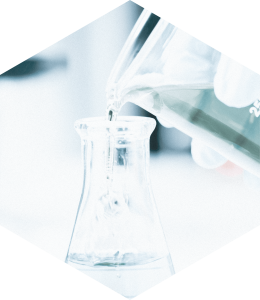 Januar 01, 1970
Januar 01, 1970Everything you need to know about organic chemistry
Unfortunately, this article is currently only in English language. We are working on a translation. Thank you for understanding.

Organic chemistry studies the compounds containing carbon, hydrogen, and many other elements (mainly oxygen, nitrogen, sulphur, and phosphor). It belongs to one of the biggest segments of chemistry with the broad range of utilization. Organic chemistry products affect our lives on a daily basis from food, drugs, cosmetics through fertilizers and diapers to fibres, electronics, and many others. Our body, as any other living organism, is a scene of many chemical reactions that are constantly in progress, without realizing it.
History of organic chemistry
The history of organic chemistry can be tracked back to ancient times when the medicine men extracted chemicals from nature sources to treat the members of their tribes. They didn’t call themselves as organic chemists, but they simply followed obtained records about the useful positive properties of things like willow bark which was used as a pain killer. Now, it is known that it contains acetylsalicylic acid, ingredient of aspirin, that was primitively extracted by chewing. This wisdom obtained during millenniums/centuries sets up the basis of modern pharmacology, which is highly dependent on the knowledge in organic chemistry.
The term – organic chemistry appeared at the beginning of the 19th century when the Jöns Jacob Berzelius, Swedish chemist, divided the chemical compounds into organic and inorganic class. He believed, as many other chemists in that time, in Vitalism – the idea that organic compounds can only originate from living organisms through the action of some vital force. Therefore, they assumed that organic compounds can’t be prepared in laboratory conditions. Berzelius as first observed isomerism, phenomenon in which more than one compounds have the same chemical formula but different structures and therefore different physical-chemical properties.
In 1828, Berzelius’s student, Friedrich Wöhler performed the first laboratory synthesis of organic compound. He mixed a silver cyanate with an ammonium chloride and obtained solid silver chloride and an aqueous ammonium cyanate. To his surprise, the solid after evaporation of water solution was not the ammonium cyanate but a urea. He was the first man who prepared organic compound from inorganic ingredients and weakened the concept of Vitalism. It was an important turning point in the evolution of organic chemistry.
Only three years younger, Justus von Liebig was another pioneer of organic chemistry, who knows and frequently collaborated with Wöhler. Both, Wöhler and Liebig met in Frankfurt in 1826 to compare reported preparations of two isomeric compounds, Liebig’s fulminic acid and Wöhler’s cyanic acid, both with the same chemical formula but with different characteristics. Prepared silver fulminate was highly explosive while silver cyanate wasn’t, which was one of the first practical observations of the isomerism.
The theory of valency
The development of better and more precise analytical tools and methods helped scientists to understand the structure of compounds and the bond formation between atoms in molecules. In 1852, British chemist Sir Edward Frankland introduced the theory of valency. Valence number indicates the amount of bonds, that atom can bond with another atom. It is a combining capacity (power) of element to form chemical bonds. Yet, we know that it is the number of electrons in the outer (valence) shell of the atom, which are able to form chemical bonds. This concept has developed in the next century to increasingly detailed descriptions of chemical bonds such as Lewis theory (1916), valence bond theory (1927), molecular orbitals (1928), VSEPR – valence shell electron pair repulsion theory (1939) and all of the advanced theories in quantum chemistry, based on the discovery of Schrödinger equation (1926).
Synthetic dye
William Henry Perkin began the revolution of organic chemistry in industry in 1856 only in the age of 18 with the patent application of the first synthetic dye, mauveine. He obtained this aniline-based dye accidentally (discovery known as serendipity) as a student while working on synthesis of quinine substance used for the treatment of malaria. Until then, all the dyes used for colouring were isolated from natural sources. The purple colour, a very expensive and rare in the nature, was a perfect product for the commercial production and brought a quick success to Perkin’s company.
Chemical companies like Bayer (1863), BASF (1865) and AGFA (1867) were found in Germany shortly after the expansion of chemical industry focused on dyes. Partnerships formed between the academia and the industry made Germany the world leader in the chemical production until 1914. Since this milestone, the pharmaceutical research and development starts to exponentially evolve in the chemical industry as a concurrent direction to the commercially successful production of dyes.
Brief history of the Aspirin
The synthesis of salicylic acid is considered to be the milestone in pharmaceutical industry. The preparation was published in 1860 by German chemist Hermann Kolbe and it is now known as Kolbe-Schmitt reaction. Besides desired analgetic and antipyretic properties, the salicylic acid has also unpleasant side effects. Felix Hoffmann, one of the chemists in Bayer company, prepared less-irritating acetylated derivative in 1897. His product, acetylsalicylic acid, was placed on market in 1899 under the brand name Aspirin and it remained until now. Many new producers and sellers appeared on market considering simple structure and preparation which caused patent litigation in the USA and Great Britain and the massive rise of marketing in drug sales. Pharmaceutical market developed to one of the most lucrative industrial businesses. There were more than 220 drugs based on acetylsalicylic acid on market after the World War II.
The Aspirin intellectual property together with all the factories in USA were bought by Sterling company in the government auction of enemy’s holdings at the end of the World War I. Scientists progressively discovered more and more effective painkillers and fever reducers, but Aspirin found a new application. In 1950 Doctor Lawrence A. Craven described the alternative use of undesired effect, the reduced blood clotting as the benefit for the patients. It took more than 40 years while Aspirin was officially approved as the prevention of thrombosis and therefore stroke and heart attack. This unique organic compound is now known to positively affect over 50 different symptoms in the treatment of 11 diseases and in the prophylaxis of 12 another. It is the most used medicament in the world with the estimated production around 40 000 tons (approx. 120 billion of pills).
Development of organic chemistry
Organic chemistry has rapidly evolved into a dynamically evolving scientific discipline with the exponential growth of newly prepared compounds each year (4.4 % annual average between 1850 – 2015, together over 14 mil. compounds). There has been a boom of synthetic procedures, analytical techniques, studies of reaction mechanisms and structural theories. The knowledge in organic chemistry was employed in many different research areas like study of living organisms and inside processes (saccharides, lipids, proteins, and DNA). Until now, more than 26 Nobel prizes were awarded in the direct connection to organic chemistry. During the 20th century, it gradually branched into sub-disciplines such as polymer chemistry, pharmacology, biochemistry, petrochemistry and numerous others.
Organic chemists focus not only on the synthesis of potentially useful compounds found in nature sources (plants, mushrooms, microorganisms etc.) but they also try to modify and simplify known structures creating new, unnatural analogues. As a result, we don’t have to tediously obtain many active compounds from a nature in very low yields, but we can synthesize them. Nowadays, we also use materials which were not even present on our planet before. Plastic materials are an excellent example, and they are present everywhere. Teflon (polytetrafluoroethylene) is an example of material, which was made accidentally during the experiments with a coolant for refrigerators.
Organic chemistry also plays an important role in today’s age of electronics full of displays and batteries. Due to their molecular size, special organic compounds are used in nanotechnologies. They can serve as conductors and rectifiers of electric current or semiconductor transistors (OFET – organic field effect transistor). Liquid crystals and organic light emitting diodes (OLEDs) are used in the imaging technologies. Special organic compounds can be also found in solar cells. One of the future visions is molecular computer which would use organic compounds switchable between two states (based on similar principle as bits 0 and 1). Organic chemistry is one of the pillars of basic research and has the broad application in many research areas.
Timeline of organic chemistry milestones
- Beginning of the 19th century: The term – organic chemistry appeared when the Jöns Jacob Berzelius, divided the chemical compounds into organic and inorganic class.
- 1828: Friedrich Wöhler performed the first laboratory synthesis of organic compound and prepared organic compound from inorganic ingredients
- 1852: Sir Edward Frankland introduced the theory of valency.
- Lewis theory (1916)
- valence bond theory (1927)
- molecular orbitals (1928)
- VSEPR – valence shell electron pair repulsion theory (1939)
- all of the advanced theories in quantum chemistry, based on the discovery of Schrödinger equation (1926).
- 1856: William Henry Perkin patent application of the first synthetic dye, mauveine.
- 1860: Hermann Kolbe – the synthesis of salicylic acid – Kolbe-Schmitt reaction.
- 1897: Felix Hoffmann (Bayer company) – acetylsalicylic acid, know as Aspirin
Conclusion
The synthesis of new organic compounds has given mankind many new and useful materials. Some people may claim that these activities are unnatural, and the products are dangerous and unhealthy. However, these molecules were created by humans from other molecules that come from nature. The question whether it is natural or not is not so important for organic chemists. They realize that the compounds can be toxic, stable, or reactive, but there is only one kind of organic chemistry. The one, that is based on scientific thoughts and ideas, and takes place in flasks and reaction apparatuses handled by a chemist. It is not a question of morality, but the effort to understand the world around us as best as we can.